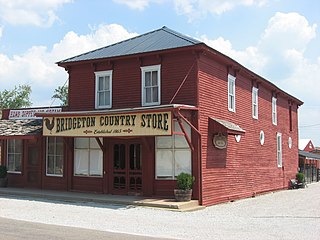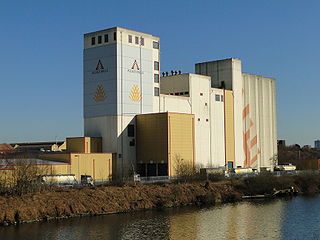
Saint Anthony Falls, or the Falls of Saint Anthony, located at the northeastern edge of downtown Minneapolis, Minnesota, is the only natural major waterfall on the Mississippi River. Throughout the mid-to-late 1800s, various dams were built atop the east and west faces of the falls to support the milling industry that spurred the growth of the city of Minneapolis. In 1880, the central face of the falls was reinforced with a sloping timber apron to stop the upstream erosion of the falls. In the 1950s, the apron was rebuilt with concrete, which makes up the most visible portion of the falls today. A series of locks were constructed in the 1950s and 1960s to extend navigation to points upstream.

Bridgeton is an unincorporated community in Raccoon Township, Parke County, in the U.S. state of Indiana. It is notable for its covered bridge, which was destroyed on April 28, 2005, by a fire set by an arsonist. A historically accurate reconstruction of the bridge was completed in October, 2006.

Watson's Mill is an historic flour and gristmill in Manotick, Ontario, Canada. It is the only working museum in the Ottawa area and one of the very few operating industrial grist mills in North America. Watson's Mill still sells stone-ground whole wheat flour which is made on site. The mill is also well known for its ghost Annabelle. The legend is that Ann Currier, wife of Joseph, haunts the mill, following her death in a tragic accident there in 1861. Watson's Mill is Manotick's most recognized landmark. Its image is used as a symbol for the village.

Phelps Mill is a flour mill in Otter Tail County, Minnesota, United States, on the Otter Tail River. The mill was built in 1888–1889 by William E. Thomas, a local entrepreneur who owned a flour and feed business in Fergus Falls. During that time, wheat was a high-demand crop, and nearly one thousand flour mills were in operation throughout Minnesota. Thomas began constructing a wooden dam on the river in the spring of 1888, although the dam was prone to leakage and had to be shored up with sandbags, dirt, gravel, and other materials. The mill itself was built by Royal Powers, who built and framed the mill without using blueprints. He was able to keep the entire plan within his head and did not even have to mark out the lumber he was cutting.

Florence Mill, also known as the Weber Mill, is a historic mill located at 9102 North 30th Street near the 30th Street exit on I-680 in the Florence community in North Omaha, Nebraska. It was built in 1846 and operated into the 1960s. It was listed on the National Register of Historic Places as Weber Mill in 1998. The mill is also known as the Mormon Mill, Grist Mill, and Old Pink Mill. It is now operated as the Winter Quarters Mill Museum and ArtLoft Gallery.

The Malvern Roller Mill, also known as Appel Mill and Malvern Milling Company, is a 19th-century grist mill located near the unincorporated village of Malvern, Illinois, in rural Whiteside County, north of Morrison, Illinois, United States. The original mill on the site, built by 1853, was destroyed by a flood and the present mill was erected in 1858. The mill's first owner was William P. Hiddleson who operated the mill until he sold to Benjamin Hough in 1871. The mill changed hands over the years until it landed under the control of George Appel in 1892. The Appel family closed the mill in 1942 but it remained in their family until 1985. The Malvern Roller Mill was added to the U.S. National Register of Historic Places in 1995.

Schech's Mill is a historic mill in Houston County, Minnesota, United States. It is one of three watermills in Minnesota still operating solely with water power and the only one to have its original millstones. Built by John Blinn in 1876, it was purchased by a Minneapolis miller, Michael Schech who had emigrated from Bavaria, Germany. The mill produced cornmeal, rye buckwheat, wheat flour, graham flour, and whole wheat cereal, which was sold in Caledonia and Houston, Minnesota. Schech's Mill is unique in the state for retaining intact and operable machinery from the 1870s, after the middlings purifier had been introduced but before millstones were supplanted by roller mills. In 1922, a concrete dam was built to replace the original wooden one.

The Western Bridge and Construction Company, located in Omaha, Nebraska, was one of the foremost bridge engineering and manufacturing companies in the Midwestern United States. Several of their bridges are now listed on the National Register of Historic Places. Their headquarters were located in the Bee Building in Downtown Omaha.

Mill City Museum is an American Minnesota Historical Society museum in Minneapolis. It opened in 2003 built in the ruins of the Washburn "A" Mill next to Mill Ruins Park on the banks of the Mississippi River. The museum focuses on the founding and growth of Minneapolis, especially flour milling and the other industries that used hydropower from Saint Anthony Falls.

A gristmill grinds cereal grain into flour and middlings. The term can refer to either the grinding mechanism or the building that holds it. Grist is grain that has been separated from its chaff in preparation for grinding.

Easton Roller Mill is a historic sawmill and grist mill located near Morgantown, Monongalia County, West Virginia. Construction began in 1864 and was completed in 1867. During the first 10 or so years, the mill changed hands from the original builder, Henry Koontz of Frostburg MD, about four times before mill-modernizer Isaac Morris bought the mill in 1894. Originally it was a 3 1/2-story rectangular, timber frame building with a shed addition; however, the shed was removed In recent years. Most mills of this era were exclusively using Burr stones for milling and grinding, however in 1894, the owner, Isaac Morris, installed roller mills for the production of high-grade white flour coming into popular demand. At that time, the Burr stone mill was relegated to grinding cornmeal, and so began a second business of cornmeal and animal feed products also sold at the Easton mill. It is probable Mr. Morris also installed the current steam engine, an 1875 Lane & Bodley 40 HP single expansion engine. The engine once ran on coal-generated steam; however, for insurance reasons, it now runs on compressed air for demonstration purposes. The mill ran under Mr. Morris' ownership until 1910. William C. Ley bought the mill in 1910 and ran it 24 hours a day until 1930. We are told that Mr. Ley was of German descent, was tall, spoke with a heavy accent, and often wore a thick black mustache under his wide brimmed hat. He was known for running a very expertly tuned operation, and keeping his equipment in perfect working order. We believe Mr. Ley potentially ran the mill seasonally through the 1930s, until his death in 1941. Between 1939 and Ley's death in 1941, Ley's daughter Estella Ley-Pickenpaugh and her husband Fred Pickenpaugh attempted to restore the mill to full working order, only to discover local wheat and grains unavailable, as most milling had moved to large-scale mills in the Midwest. During this time they may have been assisted by Mr. Ley's milling partner Frank A. Walls of Easton. It is unclear whether Walls held ownership interest in the mill at any time; however, his name appears on the cornmeal bags only. The mill was willed by Estella Ley-Pickenpaugh to the Monongalia Historical Society in 1978. In the fall-winter of 2012–2013, restoration work began at the mill. The mill is expected to be operating and touring visitors by spring 2013.

Thorp Mill is a historic building located in Thorp, Washington, United States.

The Gooseville Mill/Grist Mill is a historic mill on the North Branch Milwaukee River in Gooseville, Wisconsin. The mill was built in 1879 to replace an 1855 mill that had burned down. The mill is a small custom mill with board and batten siding and is typical of the custom mills common in Sheboygan County in the 1800s. A Lefel turbine powered the mill, replacing the paddle wheel used in the 1855 mill. A burr mill was used to grind the grain processed at the mill. As of 1984, the mill was still operational and occasionally used as a sawmill.

The Nathan Cooper Gristmill is a historic gristmill on the Black River located at 66 NJ Route 24 in Chester Township, Morris County, New Jersey. It was added to the National Register of Historic Places on November 21, 1976 for its significance in industry.

Champion Mill is a historic flour and feed mill in Champion, in the southwestern part of the state of Nebraska, in the Midwestern United States. Built in 1888 and rebuilt in 1892 after a fire, the mill was used commercially until 1968. It is now a museum and park run by Chase County preserving the state's last working water-powered mill. The mill, headrace, and dam were added to the National Register of Historic Places as a historic district in 1988.

Drinkwater & Schriver Mill, also known as Cedar Point Mill, was listed on the National Register of Historic Places (NRHP) in 2006. It is located in Cedar Point, Kansas, United States.

Hodgson-Aid Mill, also known as Hodgson Water Mill and Aid-Hodgson Mill, is a historic grist mill located on Bryant Creek near Sycamore, Ozark County, Missouri. It was constructed around 1897, and is a 3+1⁄2-story, timber frame mill building covered with red-painted weatherboards. Associated with the mill are the man-made mill pond and the limestone barrel vault constructed at the base of the cliff where Hodgson Spring discharges. The mill has not been in operation since 1976. It is privately owned.

The Neligh Mill Bridge is a truss bridge which brings Elm St. over the Elkhorn River in Neligh in Antelope County, Nebraska. It was built in 1910 and was listed on the National Register of Historic Places in 1992. It has also been known as the Elm Street Bridge and as Elkhorn River Bridge.

The Paoli Mills is an early mill complex on the Sugar River in Paoli, Wisconsin, including the remains of a sawmill built in 1849 and a largely intact flour mill begun in the 1860s. In 1979 the complex was added to the National Register of Historic Places.

Gadow's Mill is a former grist mill on the Milwaukee River in West Bend, Wisconsin, United States, that is listed on the National Register of Historic Places (NRHP).


























